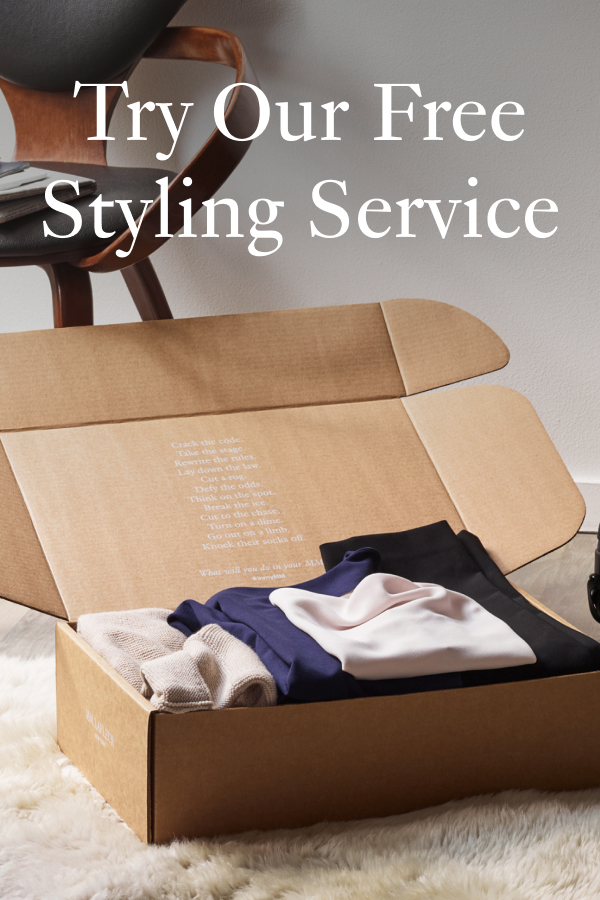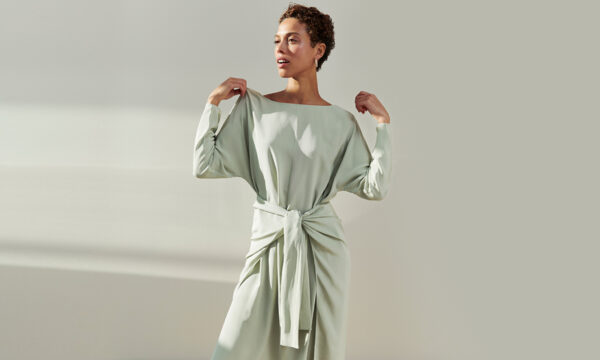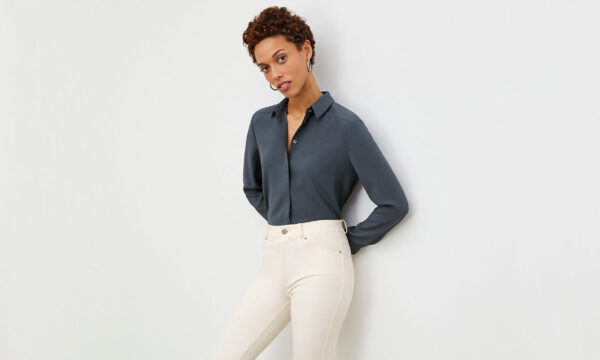
The Gaia jacket and Tinsley trousers.
How to Build a Sustainable Wardrobe
Living sustainably and having great style are not mutually exclusive, and a few small changes to how you shop for and style your clothes can make a big difference.
Want more M Dash?
Sign up for our weekly newsletter.
Thank you!
If the phrase “sustainable wardrobe” feels broad and nebulous, that’s because it is. In recent years, “sustainability” has become a catch-all buzzword used for everything from the canvas tote you bring to the grocery store to the carbon offsets companies purchase to mitigate the environmental damage they cause. And zooming in on a specific industry like fashion doesn’t make things any less complicated.
There are so many approaches you can take to eco-conscious dressing, it can feel overwhelming whether you’re totally new to the world of sustainability or a longtime proponent. To help shed some light, I spoke with three fashion-industry experts who incorporate sustainability into their work in different ways.
Audrey, M.M.’s Senior Director of R&D and Production, is in charge of sourcing our textiles and overseeing the supply chain. For the past year, she’s been working closely with the sustainability consultants at Eleven Radius to become an expert in eco-conscious clothing production. Shelby is our Senior Merchandising & Product Development Manager, and a big part of her role is ensuring that everything we design is versatile, long-lasting, and easy to pair with M.M. pieces from past seasons. And finally, Liz Teich (@thenewyorkstylist) is a professional stylist and blogger who teaches others how to shop sustainably and have great style—because they’re not mutually exclusive!
Here are their recommendations for building a sustainable wardrobe, from the pieces you buy, to the way you wear and care for them, to what you do when you’re done with them.
How to Build a Sustainable Wardrobe
SHOPPING FOR CLOTHES
Support Companies Making Sustainable Strides
“Ever since I was little, I’ve preferred to buy one quality piece over five cheaply made pieces,” says Audrey. “I like figuring out how to switch up that one piece in my wardrobe. But more importantly, I would much rather have something that I know was made in a good, eco-friendly way and will last.”
Audrey’s quality-over-quantity approach to fashion is apparent in the way she runs M.M.’s production team today. “Sustainability is really built into the way we design clothes at M.M.,” she explains. “These are quality items, not fast fashion; our pieces are not meant to be thrown away. We come at this from two angles: First, we prioritize high-quality production partners and fabrics, so these items should last you a long time. And second, we’re not designing high-trend items, and our new pieces are meant to work with your old M.M. We want to help you use those pieces over and over, and maybe change up one element to get a fresh look for the next year.”
For Liz’s part, she uses her platform to lift up brands that are making strides in the right direction. “I’ve been posting about sustainability since I started blogging in 2011, but in January of 2021, I vowed only to work with brands that were on the road to being more sustainable,” she says. “And to this day, I will turn down partnerships with brands that are not doing anything [for sustainability]. Whether it’s implementing more sustainable fabrics or facilitating resale, every little bit counts. I tell this to all my clients: We as consumers make a huge difference in how the industry will run and whether sustainable brands will succeed. If we continue to demand sustainable fashion, one day, it will be more cost-effective, because it’s going to be the new normal.”

The Malala dress in Recycled WonderTex, the Rowan flats, and the Claressa earrings.
Buy Better Fabrics
M.M. released its first recycled fabric, Recycled WonderTex, in 2020—and we’re not planning to stop anytime soon. “After our co-founder Miyako had her daughter in 2018, she had this revelation that was like, ‘Oh man, I need to protect this Earth for the next generation,’” explains Audrey. “Miyako realized that if we were going to have an impact, we needed to start by looking at our core fabrics and converting them to preferred materials.” Since then, we’ve also introduced fabrics like Eco Soft Wave and organic cotton.
But of course, creating responsible fabrics won’t have an impact if they don’t look and feel as good as less sustainable options. Even if you want to make your wardrobe more sustainable, sacrificing on comfort is never a good option. “I communicate with our customers often and hear all their feedback, positive and negative,” says Shelby. “When we were developing Recycled WonderTex, we were really concerned about getting the hand feel just right. The fact that our customers now love this material has been really encouraging, and it feels so good knowing that people like the direction we’re going with recycled fabrics.”

The Emily dress in Recycled WonderTex.
Expand Your Definition of “Sustainability”
To truly shop responsibly, we need to look beyond the clothes themselves, and Audrey explains that there’s an urgent need to expand the conversation around sustainability to include human rights. “The things that people talk about the most [when it comes to sustainable fashion] are textiles and waste,” she says. “And while these environmental impacts are incredibly important, we don’t talk enough about the human rights impacts of our industry. 75% of the fashion industry is women, and of that 75%, only 2% are earning a living wage. Caring for the people on our planet is an equally important part of sustainability as caring for the planet itself, and several of our company goals center around promoting gender equality throughout our supply chain.”
“Your wallet is your vote, and where you choose to spend your money makes an impact,” says Audrey. “If you research the brands you’re shopping with and support the ones that are trying to make a shift for the better, it creates a domino effect where we’re able to push our suppliers to do things like create new materials and pay their workers higher wages.”

The Ashley dress in Recycled WonderTex and the Ella sandals.

The Lagarde shirt, the Horton pants, and the Claressa earrings.
WEARING CLOTHES
Prioritize Creativity Over Quantity
During her time in the fashion industry, Liz has learned that you don’t need to have an unlimited wardrobe to express yourself with style. “I’ve been blogging and doing the whole Instagram content-creator thing for almost 11 years now,” says Liz. “And when I first started out, I would have a new outfit every day of the week and post about it on my blog. I quickly learned that not only was that not great for my wallet, but it also wasn’t great for the environment.”
“It came with experience and maturity, but over time, I learned that it’s more about getting creative with what you have than constantly acquiring new clothes,” she explains. “Part of what I show on my blog and Instagram is how to style staple pieces in different ways. Take something as simple as how to style a white button-down—I could post that over and over, because there are so many ways to have fun with it.”
If you want a more eco-friendly wardrobe, don’t buy a new piece for every single special occasion; and don’t buy a new pair of jeans every time a fresh trend pops up. Instead, invest in versatility and figure out what timeless style looks like to you.

The Gaia jacket, Antoinette top, and Mejia pants.
Invest in Staples
“Staple pieces” will mean something different to everyone, depending on your lifestyle, fit preferences, and dress code needs. But there are a few core items that can go a long way toward maximizing anyone’s outfit possibilities. “If you’re going to invest in one piece, I always recommend a great blazer,” says Liz. “A blazer is all about fit and tailoring, and you really can tell the difference when a blazer isn’t high-quality. Even if you’re not going to an office, you can throw it over a dress or jeans in place of a jacket to make a complete outfit.”
“It also helps to think about pieces that you can wear for different aspects of your life,” she adds. “For me, that often means going from the playground to a meeting. I love M.M.’s pants with adjustable hems, because I can take them from day to night with a heel or a sneaker, and I don’t have to get a new pair of pants for each aspect of my life.”
“Finally, I recommend a versatile white button-down to everyone. The Lagarde shirt, which I’m wearing right now, is one of my favorite pieces, and I’ve worn it for years. I’m a mom, so the fact that it’s machine-washable is huge—it’s something that I can have forever.”

The Nejvi top, Astor skirt, and Ginger pumps.
Embrace the Power of Tailoring
Caring for your clothes properly and learning how to repair damaged pieces—which we’ve written about extensively—can go a long way toward making them last as long as possible. But Liz also emphasizes the importance of tailoring. “Small tailoring tweaks, like adding darts to a pair of pants or getting a top taken in, can really make a difference,” she says. “Even clothes that are tailored beautifully have to be altered for different bodies.”
“I once had a client who was a lawyer, and she wore nothing but suits to work. She contacted me saying, ‘I’m going to need all new suits, but I’d like you to come and look at what I have in my closet and see what we can salvage.’ I looked at all of her suits, and they were beautifully tailored, but their silhouettes were dated. I sent her to a tailor and told her what to ask for, and in the end, she didn’t need to buy a single new piece. She told me, ‘Oh my God, you saved me so much money, and you saved all these gorgeous suits.’”
RESELLING AND RECYCLING CLOTHES
Buy and Sell Pre-Loved Pieces
Buying and selling pre-loved clothing is one of the best ways to reduce its carbon footprint—which is why we have our very own resale site—but secondhand shopping can be hard to navigate. Luckily, Liz is a seasoned pro. “When you’re shopping secondhand, you should always go in with something in mind,” she advises. “And don’t be disappointed if you can’t find the exact thing you were looking for—because you might end up finding something even more exciting.”
Equally tricky is figuring out when it’s time to let go of pieces in your wardrobe. Liz has a simple and effective approach: “A lot of clients will say, ‘I haven’t worn this in X amount of time,’ and I don’t go by that. To me, it’s about how you feel in the clothing. If you put it on and you don’t feel amazing in it, or it doesn’t fit you, you either have to move on or tailor it.”

The Brodie top (similar: Axam turtleneck), Zhou culottes, and Rowan flats.
Do Your Homework on Textile Recycling
While we’d love to believe that everything we throw into those big blue bins actually gets recycled, it’s sadly not the case, and many donated and recycled items ultimately end up in landfills. Luckily, there are companies like thredUP that will either resell clothes or ensure that they’re properly recycled. “I personally love thredUP, because I constantly struggle with how to responsibly get rid of my unwanted clothes,” says Shelby. “Reselling to thrift stores can be a lot of work, and you hear these horror stories about tons of donated items going straight to landfills.”

The Jillian dress (available in bright coral).
Give Yourself Grace
They say that perfect is the enemy of good, and that’s definitely the case when it comes to making sustainable choices. Whether you’re being more conscious about where you shop, patching a hole in a shirt you previously would have thrown away, or buying a used item instead of a new one, Audrey, Shelby, and Liz all emphasize that every little effort makes a difference. And reading this article was a great place to start.










